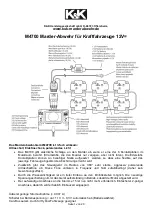
55908059-01
34
PRESSURE TESTING
20.
F Gas certificate number
21.
Is the system to be pressure tested with Oxygen
Free Nitrogen?
If yes go to question 22
If no rectify and reassess
22.
What is the required strength pressure test?
23.
What is the required tightness pressure test?
24.
Has the pressure been incrementally increased
in a safe manner?
If yes go to question 25
If no rectify and reassess
25.
Has the system passed the strength test?
If yes go to question 26
If no rectify and reassess
26.
Has the system passed the tightness test?
If yes go to question 27
If no rectify and reassess
27.
What was the duration of the tightness test?
28.
Has the system been safely de-pressurised into a
well ventilated environment?
If yes go to question 29
If no rectify and reassess
EVACUATION
29.
Has a flammable gas leak detector been
energised and placed in a suitable location?
If yes go to question 30
If no rectify and reassess
30.
Have all possible ignition sources been removed
from the work area?
If yes go to question 31
If no rectify and reassess
31.
Has a suitable vacuum pump been fitted to the
system?
If yes go to question 32
If no rectify and reassess
32.
Is the oil level satisfactory?
If yes go to question 33
If no rectify and reassess
33.
Is the exhaust able to be discharged into a safe
environment away from ignition source?
If yes go to question 34
If no rectify and reassess
34.
Has a vacuum gauge been connected to the
system?
If yes go to question 35
If no rectify and reassess
35.
Has a suitable vacuum been achieved and held
for a suitable period of time?
If yes go to question 36
If no rectify and reassess
CHARGING OF REFRIGERANT
36.
Is additional refrigerant charge required?
If yes go to question 37
If no go to question 44
37.
Is a suitable charging cylinder available fitted
with the correct bottle adaptor?
If yes go to question 38
If no rectify and reassess
38.
Have you selected a calibrated weighing
platform?
If yes go to question 39
If no rectify and reassess
39.
Calibration certificate number
40.
Has the charging hose been evacuated of air?
If yes go to question 41
If no rectify and reassess
41.
Will the system be charged in liquid or vapour
form?
42.
Has the correct additional charge been added in
accordance with the manufacturers
instructions?
If yes go to question 43
If no rectify and reassess
43.
Can the equipment be energised to remove
refrigerant from the charging hoses?
If yes go to question 44
If no rectify and reassess
44.
Have the isolation valves been opened
correctly?
If yes go to question 45
If no rectify and reassess
45.
Has the system been leak checked with a
suitable leak detector for A2L refrigerant?
If yes go to question 46
If no rectify and reassess
46.
Have the running conditions of the system been
checked/recorded?
If yes go to question 47
If no rectify and reassess
Summary of Contents for A2LCELLARMATCH
Page 1: ...55908059 01 A2LCELLARMATCH TECHNICAL MANUAL ...
Page 12: ...55908059 01 12 2G CONDENSING UNIT WIRING DIAGRAMS ...
Page 14: ...55908059 01 14 ...
Page 22: ...55908059 01 22 2K COMPONENT IDENTIFICATION SMC ...
Page 31: ...55908059 01 31 3H EVAPORATOR WIRING DIAGRAM 3I REFRIGERANT SYSTEM SCHEMATIC DIAGRAM ...


































